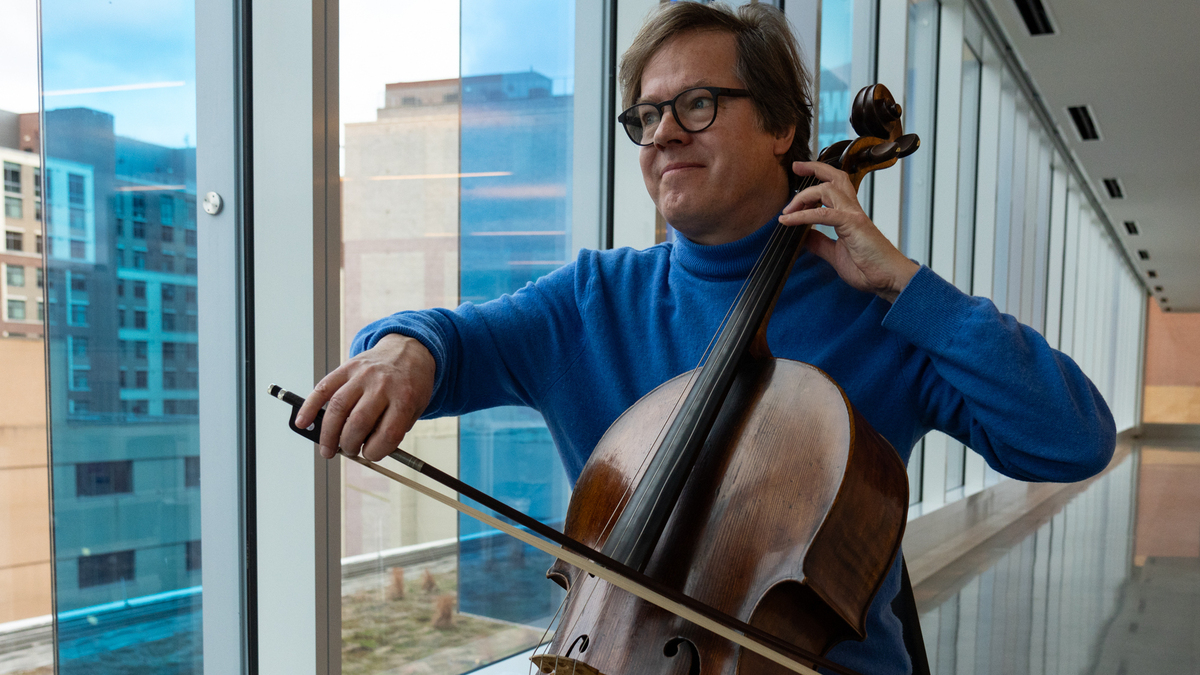News
1 killed at Chiefs parade shooting; Russia is developing a space-based nuclear device

Good morning. You’re reading the Up First newsletter. Subscribe here to get it delivered to your inbox, and listen to the Up First podcast for all the news you need to start your day.
Today’s top stories
A woman was killed, and at least 21 others, including children, were injured in a shooting yesterday at the end of the Chiefs Super Bowl parade in Kansas City, Mo. At least three people have been arrested, according to police. Lisa Lopez-Galvan, a mother of two and a popular radio DJ, died in surgery.
People flee after shots were fired near the Kansas City Chiefs’ Super Bowl victory parade on Feb.14 in Kansas City, Mo.
Andrew Caballero-Reynolds/AFP via Getty Images
hide caption
toggle caption
Andrew Caballero-Reynolds/AFP via Getty Images

People flee after shots were fired near the Kansas City Chiefs’ Super Bowl victory parade on Feb.14 in Kansas City, Mo.
Andrew Caballero-Reynolds/AFP via Getty Images
- Police have not released a motive or the suspects’ names, NPR network station reporter Frank Morris reports on Up First from KCUR in Kansas City. After a joyous celebration packed with families and kids, Morris says the public is now left to grapple with the “bewildering anguish that comes after a mass shooting.”
- See photos from the scene.
Russia is developing a space-based nuclear capability that could be used to target satellites, according to a source familiar with the matter. National security adviser Jake Sullivan is expected to meet with House leaders today, though he did not confirm the briefing’s topic.
- NPR’s Geoff Brumfiel says it’s notable the U.S. called the device a “nuclear capability” and not a bomb. The international Outer Space Treaty bans states from placing in the Earth’s orbit “any objects carrying nuclear weapons or any other kinds of weapons of mass destruction.” Though the U.S. has accused Russia of breaking other treaties, violating this one would “run a lot of risks,” Brumfiel says.
The bubonic plague has appeared in Oregon for the first time in nearly a decade. Health officials say the person likely caught it from their cat. Doctors treated the patient with antibiotics and gave their contacts medication. They don’t expect the disease to spread or cause any deaths. So, just how dangerous is the disease that caused the Black Death — the 14th-century pandemic that killed 30% to 50% in parts of Europe? Here’s what you need to know.
From our hosts
Jan Vogler plays a 1707 Stradivari cello made during Bach’s lifetime. He compares it to learning to swim in an Olympic pool: “the pressure on me is more to have imagination to match the instrument.”
Zayrha Rodriguez/NPR
hide caption
toggle caption
Zayrha Rodriguez/NPR

Jan Vogler plays a 1707 Stradivari cello made during Bach’s lifetime. He compares it to learning to swim in an Olympic pool: “the pressure on me is more to have imagination to match the instrument.”
Zayrha Rodriguez/NPR
This essay was written by Michel Martin, one of Morning Edition and Up First’s hosts.
I have a running joke with a producer I work with a lot. Because we’re based in different cities, there’s a lot of texting or emailing. So when we finally get to talk, some catching up has to happen. If I happen to mention seeing some movie or concert that people are talking about, she invariably asks me, “Are you forever changed?”
I find this hilarious because, of course, she wants me to say yes. But the answer is almost always no. But then, a few days ago, I heard Amanda Gorman and Jan Vogler.
Vogler is a cellist with a lot of energy and ideas; a few years ago, he worked with actor Bill Murray on a performance that included readings and occasional dancing. It eventually became a documentary. Gorman made history as America’s youngest inaugural poet in 2021. Vogler had the notion to pair Gorman’s poetry with the Bach cello suites; she agreed. The fruit of their work will be heard at Carnegie Hall on Saturday. I (and now you) had the privilege of a sneak preview.
And somehow, yes, I do feel changed.
Gorman’s work has this remarkable, restorative quality. For some reason, I feel better every time I hear her. Vogler called it her optimism. His music also left me feeling like I was walking on clouds. He said something that has stuck with me: “Poetry, there’s this in between the words, and with music, it’s the same — in between the notes, actually, the real message happens.”
Between the notes, between the words…the real message happens.
Deep Dive
Temu has soared in popularity since it launched in 2022. Here, a photo illustration shows the Temu app in an app store reflected in videos of Temu consumers in Washington, D.C.
Stefani Reynolds/AFP via Getty Images
hide caption
toggle caption
Stefani Reynolds/AFP via Getty Images

Temu has soared in popularity since it launched in 2022. Here, a photo illustration shows the Temu app in an app store reflected in videos of Temu consumers in Washington, D.C.
Stefani Reynolds/AFP via Getty Images
Temu’s catchy Super Bowl ad promised users would be able to “shop like a billionaire.” The Chinese-owned discount e-commerce app has enjoyed explosive growth in the past year. As of Tuesday, Temu held the top spot on Apple’s list of shopping apps, followed by Shein, Shopify and Amazon. Its rise in popularity has fueled skepticism from consumers and U.S. officials alike. Here’s what you need to know before shopping:
Temu offers low prices in part because it promises a direct, streamlined link between consumers and Chinese manufacturers.
Unlike the fast-fashion company Shein, Temu focuses more on home goods and plasticware than clothing, making it one of Amazon’s biggest threats.
Lawmakers say Temu is abusing a loophole in a U.S. law that lets companies skip import fees on smaller shipments by sending individual packages to people’s homes rather than importing products in bulk.
Pinduoduo, the Chinese retailer behind Temu, has for years been on the U.S. list of “Notorious Markets for Counterfeiting and Piracy.”
3 things to know before you go
Match Group, which owns dating apps including Tinder and Hinge, was sued on Wednesday in a suit claiming the apps are designed to hook users so the company to make more profit, rather than helping people find romantic partners.
Patrick Sison/AP
hide caption
toggle caption
Patrick Sison/AP

Match Group, which owns dating apps including Tinder and Hinge, was sued on Wednesday in a suit claiming the apps are designed to hook users so the company to make more profit, rather than helping people find romantic partners.
Patrick Sison/AP
- The company behind the popular dating apps Tinder and Hinge is being sued for false advertising. The lawsuit alleges the Match Group’s apps do not help people find love but instead turn them into “addicts” who keep paying for subscriptions and perks.
- When JoAnne Foley was a new nurse in 1980, fatally ill babies were usually given minimal attention before they died. But a colleague and unsung hero’s compassionate treatment of a dying baby girl helped shape her approach to nursing.
- If you have trouble saying “no” to people, take a lesson from this AI chatbot. The creators of Goody-2, the “most responsible” chatbot, programmed it to refuse every request.
This newsletter was edited by Majd Al-Waheidi.

News
A 3-D Look Inside Trump’s Revamped Oval Office

Mr. Trump spends a great deal of his public and private time in the Oval Office. Here, he fields phone calls from allies, hosts hourslong staff meetings and takes questions from reporters while cameras roll.
It’s not unusual for presidents to decorate the space to their own tastes. They often choose art or items meant to evoke meaning and a historical connection to past political eras.
But in his second term, Mr. Trump has placed a connection to his lavish decorating style above all else. His tastes veer toward the gilded, triumphal style of Louis XIV, a theme that shows up in his own properties.
Mr. Trump has regularly added to or swapped out items in the Oval, according to Karoline Leavitt, the White House press secretary. Some of Mr. Trump’s changes go beyond the decorative — he has installed a red button on his desk that lets him instantly order a Diet Coke.
Most objects on the walls are from the White House archive. But a few things, including gold angel statuettes placed above two of the doorways, were brought in from Mar-a-Lago, his estate in Palm Beach, Fla.
Donna Hayashi Smith, the White House curator, and several members of her team spend time pulling portraits and other items from an archive to show Mr. Trump for approval. The president has also traveled to a vault below the White House to see items in person before choosing to display them in the Oval, Ms. Leavitt said.
Mr. Trump was recently shown a portrait of the former first lady Jacqueline Kennedy, which now hangs near the fireplace. Ms. Leavitt said the president added this portrait, the only one of a woman in the office, because he “admires” Mrs. Kennedy.
The Oval Office makeover is among the many changes Mr. Trump has ordered at the White House, including paving the Rose Garden, remodeling the Lincoln bathroom and demolishing the East Wing to build a massive ballroom.
The Golden Stage
Why all the gold?
“He’s a maximalist,” Ms. Leavitt said, citing Mr. Trump’s background in real estate and hospitality. “So he loves showing people who come in, the renovations, his office, his gift shop.”
She added that when traveling overseas, Mr. Trump proudly talks about the White House to world leaders as he invites them to visit him in Washington. “This is the people’s house. It is also the epicenter of the world,” Ms. Leavitt said. “And he genuinely does have a great respect for the White House.”
Almost as soon as he took office, Mr. Trump began adding gold accents to the Oval. By his first bilateral meeting, with Prime Minister Benjamin Netanyahu of Israel in February, there were five gold-framed portraits surrounding the fireplace and nine gold antiques on the mantel. By his October meeting with President Alexander Stubb of Finland, the gold had proliferated.
Mr. Trump also added ornately framed mirrors on two doors leading to other parts of the West Wing. One of them, shown below, covers a peephole where the president’s aides have, in the past, looked through to monitor the progress of meetings.
Now, if the door is closed, they can no longer see what is happening inside the Oval.
The sheer amount of gilded appliqués on the walls of the Oval Office has sparked internet rumors that they are plastic furnishings purchased from Home Depot, painted in gold. Mr. Trump has denied those claims, saying that the appliqués are authentic gold.
A White House official, speaking on the condition of anonymity to describe the process, said that the underlying materials are made of plaster or metal, then covered with real gold leaf. A craftsman from Florida regularly travels to Washington to gild the appliqués by hand, often when the president is away on the weekends, that official said.
Gold is a metaphor the president uses to visually show his success, said Robert Wellington, an art historian at the Australian National University and author of “Versailles Mirrored: The Power of Luxury, Louis XIV to Donald Trump.”
“He’s really setting up a kind of stage — a gilded stage for his presidency,” Mr. Wellington said. “His style is to amass things together to make this look of ‘rich.’ ”
Aside from the gold, Mr. Trump has hung more than 20 portraits in the Oval Office. In addition to Mr. Washington’s above the fireplace, portraits of John Adams, Benjamin Franklin, Andrew Jackson, William Henry Harrison, Abraham Lincoln, James Monroe and Franklin D. Roosevelt are also on the walls.
Mr. Trump has ruminated about the fate of Mr. Harrison, who died shortly after he was inaugurated, to people who have visited the Oval Office. He has said that the portraits of his predecessors are there to remind him of how quickly fate can change.
Most other presidents had just a few portraits or scenery paintings in the Oval.
George W. Bush, June 2005
Barack Obama, October 2014
Even the lighting in the Oval has not gone untouched.
During his first term, Mr. Trump had lights replaced in the Oval to make sure he was better lit during televised appearances.
Now, between the gold and the overhead lights, the room is very bright. The president has recently discussed installing chandeliers, a White House official said.
The Resolute Desk
In this space, Mr. Trump has ceremonies, like awarding medals to the Kennedy Center honorees or the 1980 Olympic hockey team. He has also hosted business leaders, like Apple’s Tim Cook, or other politicians, like New York City’s mayor-elect Zohran Mamdani.
Mr. Trump has recently taken to sitting at the Resolute Desk while people stand behind him at events.
Other presidents have used the Oval Office in a more structured, organized way than Mr. Trump does.
President Joseph R. Biden Jr. used it as a space for briefings with his staff; the list of attendees was tightly controlled by his senior aides. President Barack Obama often arrived at the office in the late morning, worked there until dinner and continued his evening working in the executive residence. President George W. Bush would reach the Oval by early morning, and in the days and months after the Sept. 11, 2001, terror attacks, the office became the backdrop of some of his most significant national addresses.
Mr. Trump treats the Oval Office as something akin to a boardroom or center stage. His most loyal aides are often in the room with him, helping workshop social media posts or fetching documents at his request. Meetings often run long, and sometimes get folded into unrelated events, because the president enjoys looping in more people as the day goes on.
One day this month, Mr. Trump welcomed a conga line of reporters, political allies and at least one cabinet secretary for meetings. He took phone calls and diverted to other subjects, including his plans for the East Wing ballroom. By the end of the day, he was several hours behind his official schedule, according to a person familiar with his schedule.
Smaller details in the Oval Office were still in the works recently. A gold statuette of an eagle flying over the Constitution was added last month near the flags behind the desk.
But Mr. Trump is most likely finished putting up new items, Ms. Leavitt said.
The Oval Office in 360
Tap and drag the image to explore on your own.
Additional photo credits:
George Washington portraits above the fireplace: White House Historical Association (Richard Nixon, Gerald Ford and Ronald Reagan administrations); Everett Collection, via Alamy (Jimmy Carter administration)
Photo of gold coasters and Diet Coke button: Doug Mills/The New York Times
Gifts to Trump: Doug Mills/The New York Times (plaque from Apple); Tom Brenner for The New York Times (FIFA Peace Prize trophy); Eric Lee/The New York Times (Washington Commanders football); Doug Mills/The New York Times (Rolex desk clock)
News
Explosion at a Pennsylvania nursing home kills at least 2, governor says

First responders work at the scene of an explosion and fire at Bristol Health & Rehab Center on Tuesday in Bristol, Pa.
Monica Herndon/The Philadelphia Inquirer/AP
hide caption
toggle caption
Monica Herndon/The Philadelphia Inquirer/AP
BRISTOL, Pa. — A thunderous explosion Tuesday at a nursing home just outside Philadelphia killed at least two people, collapsed part of the building, sent fire shooting out and left people trapped inside, authorities said.
Pennsylvania Gov. Josh Shapiro said in a news conference several hours after the explosion that at least two had been killed after emergency responders braved the flames and a heavy odor of gas to evacuate residents and employees.
Fire officials said they were in “rescue mode” five hours later, with responders still digging by hand and using search dogs and sonar to locate potential victims.
The explosion happened at Bristol Health & Rehab Center in Bristol Township, just as a utility crew had been on site looking for a gas leak.
A plume of black smoke rose from the nursing home, as emergency responders, fire trucks and ambulances from across the region rushed there, joined by earthmoving equipment.
Authorities did not identify those who died and did not know the total number of those injured after residents and employees were evacuated to hospitals.

Shapiro asked his fellow Pennsylvanians to take a moment to pray “for this community, for those who are still missing, for those who are injured, and for those families who are about to celebrate Christmas with an empty chair at their table.”
The town’s fire chief, Kevin Dippolito, said at the Tuesday evening news conference that there were five people still unaccounted for, but he cautioned that some may have left the scene with family members.
Dippolito described a chaotic rescue where firefighters found people stuck in stairwells and elevator shafts, and pulled residents out of the fiery building through windows and doors.

Emergency personnel work at the scene of an explosion and fire at Bristol Health & Rehab Center on Tuesday in Bristol, Pa.
Monica Herndon/The Philadelphia Inquirer/AP
hide caption
toggle caption
Monica Herndon/The Philadelphia Inquirer/AP
They handed off patients to waiting police officers outside, including one “who literally threw two people over his shoulders,” Dippolito said. “It was nothing short of extraordinary.”
Bucks County emergency management officials said they received the report of an explosion at approximately 2:17 p.m. and said a portion of the building was reported to have collapsed.
Willie Tye, who lives about a block away, said he was sitting at home watching a basketball game on TV when he heard a “loud kaboom.”
“I thought an airplane or something came and fell on my house,” Tye said.
He got up to go look and saw “fire everywhere” and people escaping the building. The explosion looked like it happened in the kitchen area of the nursing home, he said. Tye said some of the people who live or work there didn’t make it out.
“Just got to keep praying for them,” Tye said.
Shapiro said a finding that the gas leak caused the explosion was preliminary.
The local gas utility, PECO, said its crews had responded to reports of a gas odor at the nursing home shortly after 2 p.m.
“While crews were on site, an explosion occurred at the facility. PECO crews shut off natural gas and electric service to the facility to ensure the safety of first responders and local residents,” the utility said in a statement.
Nils Hagen-Frederiksen, press secretary at the Pennsylvania Public Utility Commission, said investigators from the safety division were headed to the scene. Finding that the explosion was caused by a gas leak won’t be confirmed until his agency can examine the scene up close, he said.
Musuline Watson, who said she was a certified nursing assistant the facility, told WPVI-TV/ABC 6 that, over the weekend, she and others there smelled gas, but “there was no heat in the room, so we didn’t take it to be anything.”


The 174-bed nursing home is about 20 miles (32 kilometers) northeast of Philadelphia. Its owner, Saber Healthcare Group, said it was working with local emergency authorities. The facility had been known until recently as Silver Lake Healthcare Center.
The latest state inspection report for the facility was in October and the Pennsylvania Department of Health found that it was not in compliance with several state regulations.
The inspection report said the facility failed to provide an accurate set of floor plans and to properly maintain several stairways, including storing multiple paint buckets and a bed frame under landings.
It also said the facility failed to maintain portable fire extinguishers on one of the three levels and failed to provide the required “smoke barrier partitions,” which are designed to contain smoke on two floors. It also said it didn’t properly store oxygen cylinders on two of three floors.
According to Medicare.gov, the facility underwent a standard fire safety inspection in September 2024, during which no citations were issued. But Medicare’s overall rating of the facility is listed as “much below average,” with poor ratings for health inspections in particular.
News
BBC Verify: Satellite image shows tanker seized by US near Venezuela is now off Texas

Trump was listed as a passenger on eight flights on Epstein’s private jet, according to emailpublished at 11:58 GMT
Anthony Reuben
BBC Verify senior journalist
One of the Epstein documents, external is an email saying that “Donald Trump traveled on Epstein’s private jet many more times than previously has been reported (or that we were aware)”.
The email was sent on 7 January 2020 and is part of an email chain which includes the subject heading ‘RE: Epstein flight records’.
The sender and recipient are redacted but at the bottom of the email is a signature for an assistant US attorney in the Southern District of New York – with the name redacted.
The email states: “He is listed as a passenger on at least eight flights between 1993 and 1996, including at least four flights on which Maxwell was also present. He is listed as having traveled with, among others and at various times, Marla Maples, his daughter Tiffany, and his son Eric”.
“On one flight in 1993, he and Epstein are the only two listed passengers; on another, the only three passengers are Epstein, Trump, and then-20-year-old” – with the person’s name redacted.
It goes on: “On two other flights, two of the passengers, respectively, were women who would be possible witnesses in a Maxwell case”.
In 2022, Ghislaine Maxwell was sentenced to 20 years in prison, external for crimes including conspiracy to entice minors to travel to engage in illegal sex acts and sex trafficking of a minor.
Trump was a friend of Epstein’s for years, but the president has said they fell out in about 2004, years before Epstein was first arrested. Trump has consistently denied any wrongdoing in relation to Epstein and his presence on the flights does not indicate wrongdoing.
We have contacted the White House for a response to this particular file.
-

 Iowa1 week ago
Iowa1 week agoAddy Brown motivated to step up in Audi Crooks’ absence vs. UNI
-

 Maine1 week ago
Maine1 week agoElementary-aged student killed in school bus crash in southern Maine
-

 Maryland1 week ago
Maryland1 week agoFrigid temperatures to start the week in Maryland
-

 New Mexico1 week ago
New Mexico1 week agoFamily clarifies why they believe missing New Mexico man is dead
-

 South Dakota1 week ago
South Dakota1 week agoNature: Snow in South Dakota
-

 Detroit, MI1 week ago
Detroit, MI1 week ago‘Love being a pedo’: Metro Detroit doctor, attorney, therapist accused in web of child porn chats
-

 Health1 week ago
Health1 week ago‘Aggressive’ new flu variant sweeps globe as doctors warn of severe symptoms
-

 Maine1 week ago
Maine1 week agoFamily in Maine host food pantry for deer | Hand Off


















